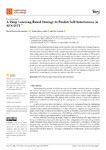Mostrar o rexistro simple do ítem
A Deep Learning-Based Strategy to Predict Self-Interference in SFN DTT
| dc.contributor.author | Pereira-Ruisánchez, Dariel | |
| dc.contributor.author | Pérez-Adán, Darian | |
| dc.contributor.author | Castedo, Luis | |
| dc.date.accessioned | 2022-01-11T16:26:54Z | |
| dc.date.available | 2022-01-11T16:26:54Z | |
| dc.date.issued | 2021 | |
| dc.identifier.citation | Pereira-Ruisánchez, D.; Pérez-Adán, D.; Castedo, L. A Deep Learning-Based Strategy to Predict Self-Interference in SFN DTT. Eng. Proc. 2021, 7, 57. https://doi.org/10.3390/engproc2021007057 | es_ES |
| dc.identifier.uri | http://hdl.handle.net/2183/29351 | |
| dc.description | This article belongs to the Proceedings of The 4th XoveTIC Conference | es_ES |
| dc.description.abstract | [Abstract] A deep learning-based strategy for the analysis of the self-interference in single frequency networks (SFNs) for digital terrestrial television (DTT) broadcasting is considered. Several laboratory measurements were performed to create a dataset that relates the self-interference parameters and some quality metrics of the resulting received signal. The laboratory setup emulates an SFN scenario with two DTT transmitters. The strongest received signal and the relative values of attenuation and delay between the signals stand for the input parameters. The modulation error ratio (MER) of the strongest received signal, the MER of the resulting signal, and the SFN gain (SFNG) are the output parameters. This dataset is used to train four different multi-layer perceptron (MLP) models to predict accurate maps of interference and signal quality metrics. The considered models are suitable as complements for any multiple frequency network (MFN) coverage software with the capability to return the signal strength and the position data. This way, the SFN self-interference behavior can be predicted by considering only a proper description of the MFN coverage. | es_ES |
| dc.description.sponsorship | This work has been funded by the Xunta de Galicia (by grant ED431C 2020/15, and grant ED431G2019/01 to support the CITIC, Centre for Information and Communications Technology Research, from the University System of Galicia), the Agencia Estatal de Investigación of Spain (by grants RED2018-102668-T and PID2019-104958RB-C42) and ERDF funds of the EU (FEDER Galicia 2014–2020 & AEI/FEDER Programs, UE), and the predoctoral grant BES-2017-081955. | es_ES |
| dc.description.sponsorship | Xunta de Galicia; ED431C 2020/15 | es_ES |
| dc.description.sponsorship | Xunta de Galicia; ED431G2019/01 | es_ES |
| dc.language.iso | eng | es_ES |
| dc.publisher | MDPI | es_ES |
| dc.relation.uri | https://doi.org/10.3390/engproc2021007057 | es_ES |
| dc.rights | Atribución 3.0 España | es_ES |
| dc.rights.uri | http://creativecommons.org/licenses/by/3.0/es/ | * |
| dc.subject | SFN | es_ES |
| dc.subject | Deep learning | es_ES |
| dc.subject | Broadcasting | es_ES |
| dc.subject | Self-interference | es_ES |
| dc.title | A Deep Learning-Based Strategy to Predict Self-Interference in SFN DTT | es_ES |
| dc.type | info:eu-repo/semantics/conferenceObject | es_ES |
| dc.rights.access | info:eu-repo/semantics/openAccess | es_ES |
| UDC.journalTitle | Engineering Proceedings | es_ES |
| UDC.volume | 7 | es_ES |
| UDC.issue | 1 | es_ES |
| UDC.startPage | 57 | es_ES |
| dc.identifier.doi | 10.3390/engproc2021007057 |






